ICOMP’2016 Tran H-S. et al
Computational methods in Manufacturing Processes 2016 – Liège,Belgium. 1
3-D finite element analysis of laser cladding process.
Application to Ti-6Al-4V
TRAN H-S. a, BRUSTEN R. a, JARDIN R. a, DUCHÊNE L. a, PAYDAS H. b,
LECOMTE BECKER J. b, HABRAKEN A. M. a
aDpt ArGEnCo, MS²F- MSM, University of Liège Chemin des Chevreuils 1, 4000 Liège, bDpt A&M, MMS, University of Liège Chemin des Chevreuils 1, 4000 Liège, Belgium.
Keywords: 3D modelling. Laser Cladding. Thermal analysis. Finite Element.
1 Introduction
Ti-6Al-4V alloy is widely used in various industrial sectors including the aerospace, automotive or petrochemical fields [1]. Its main advantages are: high strength to weight ratio good corrosion resistance, good fatigue behaviour. Besides, the laser cladding is able to process a large variety of alloys and can be used on uneven substrates. However, industries experimenting this technology face various problems including apparition of cracks and difficulties to produce net shapes. Modelling is an efficient mean to optimize these processes. In recent years, several finite element models dealing with laser cladding have been developed, they are focused on specific topics: the clad geometry [2], the influence of different processing parameters [3,4]. In this study, a 3-D thermal numerical modelling of laser cladding by powder injection as a repair technology applied to Ti-6Al-4V was developed. In order to implement the movement of the heat source in the model and the addition of material, a C++ programme was developed. Transition refinement elements are used to reduce the number of degrees of freedom. The temperature distribution and its time evolution were computed which allowed the prediction of the heat affected zone and the fusion size of the substrate. Effects of heat source distribution, energy input are investigated. Temperature measurements validate the model.
2 FE modelling of laser cladding process
In this work, the experimental study of laser cladding as a repair technology applied to Ti-6Al-4V has been used as reference [5]. A 3D model simulated the experimental case was fitted on the experimental results. To design the 3D mesh in
Tran H-S. et al ICOMP’2016
2 Computational methods in Manufacturing Processes 2016 – Liège,Belgium. an efficient way, the mesh refinement was modified depending on its position. The parts subjected to the laser source were refined in order to accurately apply heat fluxes while the extremity of the substrate is meshed as coarse as possible. To perform this operation, transition refinement elements were used. A mesh size of 0.5mm was selected for the refined mesh zone, leading to a total of 9030 solid elements for the 3D model (see Figure 1).
In powder injection technique, the continuous addition of material on the substrate was modeled by the element birth technique. Convection and radiation elements were also placed on the boundaries of the work-piece. They were used to model the heat escape to the environment.
Figure 1: 3D finite element mesh used for the numerical simulation of the laser cladding process a) top view, b) bottom view
Two types of thermal laws are required in the modelling approach: (i) the bulk heat transfer by conduction related to the heat accumulation in the solid and (ii) the surface heat transfer by convection and radiation. The classical non-linear equation of conduction is given by:
int p T T T T k k k Q c x x y y z z t (1) The heat exchange by convection and radiation is defined by:
4 4
0 0
.( . ) ( ) ( )
K T n h T T T T
(2) The heat flux distribution and its intensity were calibrated to be consistent with experimental data obtained from a thermocouple for the cladding of the 3 tracks.
100mm 15mm 20mm Path of Laser a) b)
ICOMP’2016 Tran H-S. et al
Computational methods in Manufacturing Processes 2016 – Liège,Belgium. 3 Figure 2: Temperature field of substrate at different moments of the laser cladding
process
3 Results
This paper describes a numerical model of the process of laser cladding applied to Ti-6Al-4V. A laser absorptivity coefficient of β=0.33 was numerically identified. The spatial temperature distribution shows a high gradient of temperature in the clad (Figure 2). The analysis of the results also demonstrates the impact of the applied peaks of the flux on the temperature field. The history of the temperature field provides information on the boundaries of fusion zone and heat affected zone.
References
[1] R.Boyer, G. Welsch, and E. Colling. Materials properties hand book: titanium alloys. ASM International, 978-0-87170-481-8 Materials Park, 1994.
[2] H, El Cheikh and B. Courant. 3D finite element simulation to predict the induces themal field in case of laser cladding process and half cylinder laser clad. Photonics and Optoelectronics, 1(3):55-59, October 2012.
[3] E. Toyserkani, A. Khajepour, and S. Corbin. 3-D finite element modeling of laser cladding by powder injection: effects of laser pulse shaping on the process. Optics and Lasers in Engineering. 15(3):153-160, July 2003.
[4] D. Grey, H. Long and P. Maropoulos. Effects of welding speed, energy input and heat source distribution on temperature variations in butt joint welding. Journal of materials processing technology. 167:393-401, 2005.
[5] H. Paydas, A. Mertens, R. Carrus, J. Lecomte Beckers, and J. Tchoufang Tchuidjang. Laser cladding as a repair technology for Ti-6Al-4V alloy: influence of building strategy on micro-structure and hardness. Journal of Materials and Design. 497-510, 2015. t = 0,6 s start of track 1 t = 6,3 s end of track 1 t = 12,7 s end of track 2
